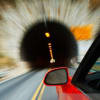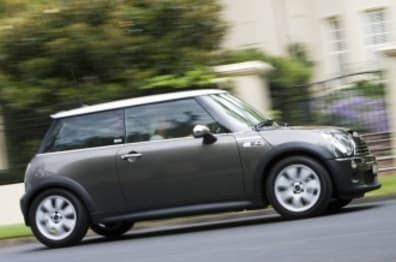
Mini Cooper S 2006 review
- Mini Cooper
- Mini Cooper 2006
- Mini Cooper Reviews
- Mini Reviews
- Mini Hatchback Range
- Hatchback
- Mini
- Small Cars
- Hot hatches
- European

It's the all new Mini, looking only slightly different to its most recent predecessor, but hiding new machinery at its heart. The new Mini Cooper S won't arrive in Australia until the first half of next year and while pricing hasn't been released, it is expected to have a "modest increase" over the current generation, which starts at $39,990 for the Cooper S manual. But the anticipated price rise can be explained through some significant changes.
The new version of the car will have a BMW Group 1.6-litre turbocharged, four-cylinder engine, produced at Hams Hall plant in England. The current supercharged engine, produced in Brazil, came out of an arrangement the BMW Group had with Chrysler.
This means its previous supercharged growl has disappeared. But not to fret, the new turbo still impresses.
The second generation produces slightly more power with 128kW at 5500rpm and 240Nm at a low 1600rpm to 5000rpm with an overboost lifting the reading to 260Nm. The current model delivers 125kW and 220Nm.
While a new version of the Mini Cooper will also be a part of the line-up, the Cooper S was the only model tested on the launch.
The winding roads and motorways of Spain were a great setting to push the new Mini Cooper S to its limits. It handled well around narrow, tight corners, gripping the road comfortably, with its low centre of gravity and go-kart like performance.
The steering and ride was stronger on the model fitted with sports suspension.
Although this doesn't come as standard, the difference can be felt with a more sturdy drive, while the lower profile and bigger tyres also contribute to the improvement.
With an ever so slight lag, the Cooper S officially shoots from 0 to 100km/h in 7.1seconds. The new Mini is slightly longer in dimensions, although you can't really tell by looking at it. The extra space provides more room in the engine bay, which has also been adjusted to accommodate future pedestrian safety standards, with more room between the body and the engine.
On the outside, the new front radiator grille is now one complete unit and changes have been made to the front lights. The front end has also been given a more masculine look, with the engine compartment lid curving up.
The rear and the shoulders are more powerful and sportier in design and changes to the exterior are topped off with chrome insignias.
The inside feels much roomier, especially for the front passenger who enjoys considerable leg room for such a small car.
Even the space in the back seems to be a little more generous than before, although long trips would still be a challenge for most adult passengers.
An unusual feature on this car, boasted by the BMW Group as the only premium small car in the world, is the very large speedometer which sits on the middle of the dash. This was a feature on the previous model overseas but was changed for the Australian market to meet ADR (design rule) requirements.
But as these have now merged with European regulations, Australia's new Mini will also feature this large speedometer, bigger than the previous European model to allow extra room for an optional satellite navigation system.
While you can appreciate the nostalgia of mirroring the location of the speedometer from the original Mini, you do find yourself forgetting to keep an eye on your speed, as well as the fact that lead-foots will be quickly caught out by everyone else in the car.
Sitting a great distance from the tachometer, it also takes some of the fun away from monitoring the speed and revs at the same time. Needless to say, it's not the most practical of locations.
The dashboard styling has changed and buttons for the stereo and airconditioning are very straightforward and easy to use. The new seats also make a difference, holding your body firmly in place.
The six-speed manual transmission took some getting used to, as it's a little rough in shifting and reverse was particularly hard to find at first. Fuel consumption on the new Mini comes in at a claimed 6.9-litres per 100km.
The new Mini is not short on safety features. Six airbags, ABS, Electronic Brakeforce Distribution, Cornering Brake Control and Automatic Stability Control and Traction are all standard on the Cooper S.
The Mini was particularly a good vehicle to trial as a left-hand drive, as well as driving on what is ultimately the wrong side of the road for an Aussie girl. Apart from grabbing the driver's door to change gears a couple of times, the experience was smooth sailing.
The Cooper S is a great little agile performer and there's a lot of fun to be had in the driver's seat, pumping the accelerator and letting your hair down.
As mentioned, the new generation will also include the Cooper, with a 1.6-litre, four-cylinder engine, with 88kW at 6000rpm and 160Nm at 4250rpm. It has a claimed fuel consumption of 5.8-litres per 100km.
The current generation of the Mini will be manufactured until December and the Cabrio will not be updated either.
Pricing guides
Range and Specs
| Vehicle | Specs | Price* | |
|---|---|---|---|
| Park Lane | 1.6L, ULP, CVT AUTO | $5,170 – 7,590 | 2006 Mini Cooper 2006 Park Lane Pricing and Specs |
| Checkmate | 1.6L, ULP, 5 SP MAN | $4,840 – 7,150 | 2006 Mini Cooper 2006 Checkmate Pricing and Specs |
| Chilli | 1.6L, ULP, CVT AUTO | $5,060 – 7,370 | 2006 Mini Cooper 2006 Chilli Pricing and Specs |
| S Checkmate | 1.6L, ULP, 6 SP MAN | $6,380 – 9,020 | 2006 Mini Cooper 2006 S Checkmate Pricing and Specs |
$6,050
Lowest price, based on third party pricing data









